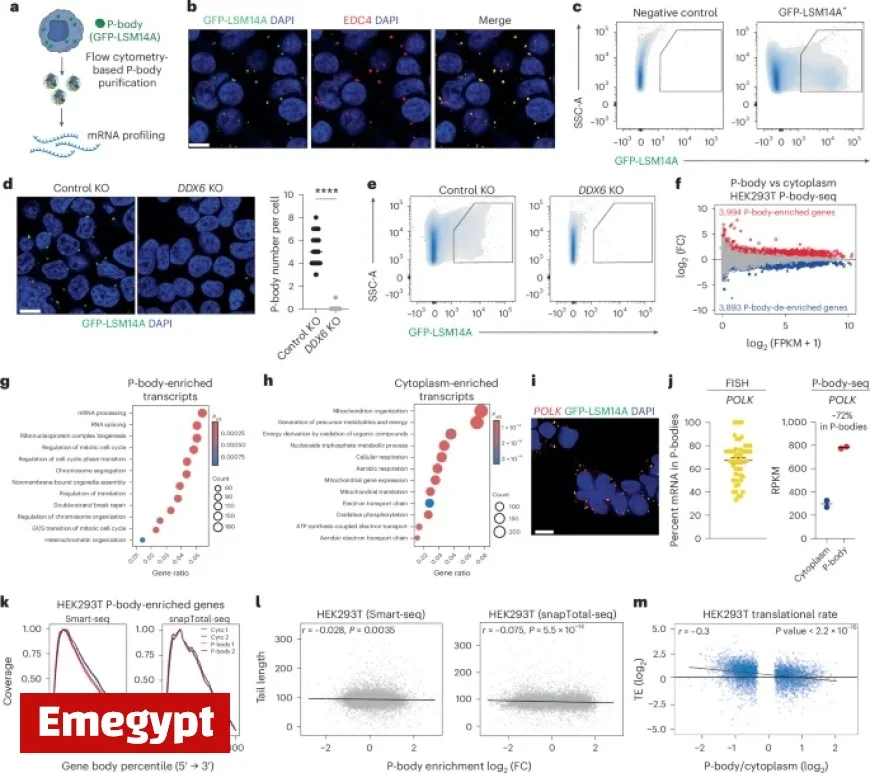How Selective RNA Sequestration in Biomolecular Condensates Guides Cell Fate Transitions

The study of RNA dynamics within cells reveals the pivotal role of selective RNA sequestration in biomolecular condensates, specifically P-bodies, during cell fate transitions. This research focuses on how these condensates influence gene expression by sequestering specific mRNAs. The analysis emphasizes the significance of biomolecular condensates in guiding developmental decisions in various cell types.
P-body Purification in HEK293T Cells
To investigate P-body contents, researchers adopted a fluorescence-activated sorting technique using a green fluorescent protein (GFP)-LSM14A construct in HEK293T cells. LSM14A is known for its presence in P-bodies, and colocalization with EDC4 confirmed the identification of these structures. The isolation of intact GFP-LSM14A particles was successful post-lysis, providing insights into RNA presence through subsequent staining procedures.
Impacts of DDX6 Depletion
- DDX6 depletion via shRNA and CRISPR resulted in the complete loss of P-body particles, underscoring its role in P-body integrity.
- RNA was localized within GFP-LSM14A particles, demonstrating successful identification of P-body contents.
Profiling P-body Contents with P-body-seq
Through P-body sequencing (P-body-seq), a total of 3,994 mRNAs were found to be enriched in P-bodies compared to cytoplasmic fractions of HEK293T cells. Gene ontology (GO) analysis indicated that these mRNAs play crucial roles in RNA processing, transcription, chromatin organization, and cell cycle regulation.
Distinct RNA Biotypes in P-bodies
The research identified diverse RNA biotypes, including protein-coding mRNAs and long intergenic non-coding RNAs (lincRNAs), within P-bodies. Importantly, it was observed that P-body-associated mRNAs exhibited low translation efficiency, suggesting their role in translational repression during cellular processes related to differentiation.
Cell Type-Specific Sequestration
The study extended P-body-seq analysis across different human cell types and developmental stages. Researchers integrated GFP-LSM14A into human embryonic stem cells (ESCs) and differentiated them into various progenitor states. Each cell type demonstrated distinct P-body profiles, indicating that RNA sequestration varies according to cellular identity.
Functional Importance of P-body Sequestration
- The presence of unique mRNA profiles in P-bodies highlights their role in maintaining cell identity during differentiation.
- Analysis of human pluripotent stem cells indicated that P-bodies facilitate or hinder transitions between different cell states by sequestering fate-instructive factors.
Conservation Across Species
Research findings suggest that RNA sequestration in P-bodies is conserved among various vertebrate species, including both human and mouse embryonic stem cells. This conservation underscores the evolutionary significance of P-body functions related to RNA dynamics during development.
Manipulating P-body Formation for Cell Fate Changes
The study also explored manipulating P-body contents to influence cell fate conversion. Suppression of key P-body components, such as DDX6, significantly increased differentiation rates toward totipotent-like states in human and mouse cells. This manipulation opening a potential pathway for enhancing the generation of clinically relevant cell types.
Conclusion
This research unveils crucial insights into how selective RNA sequestration within biomolecular condensates like P-bodies orchestrates cell fate transitions. Understanding these dynamics fosters advancements in regenerative medicine and therapeutic applications by harnessing the regulatory power of P-bodies in stem cell biology.































